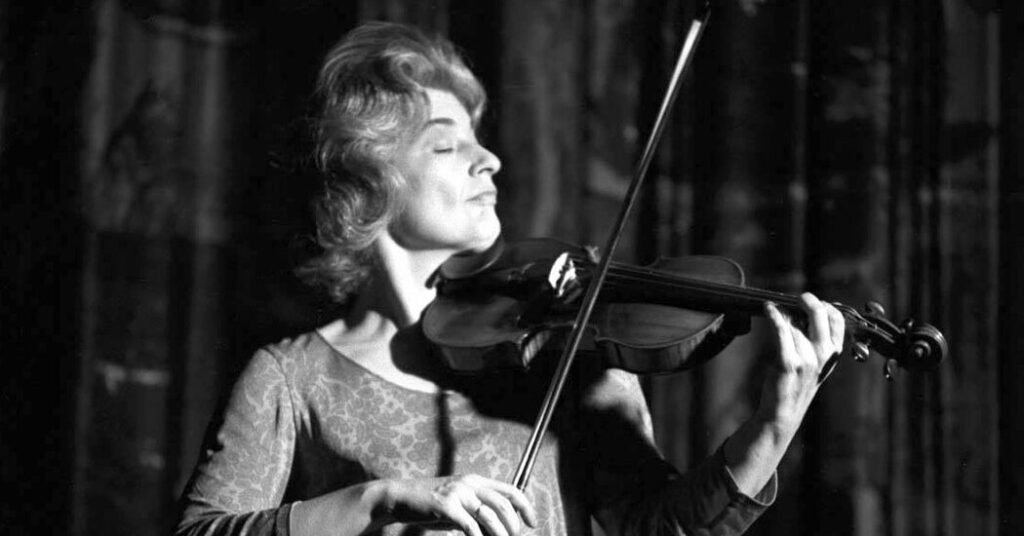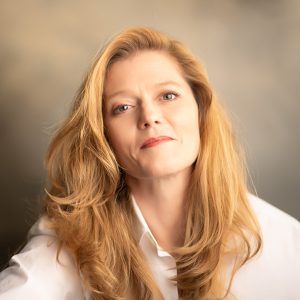Overlooked No More: Miriam Solovieff, Lauded Violinist Who Suffered Tragedy

This article is part of Overlooked, a series of obituaries about remarkable people whose deaths, beginning in 1851, went unreported in The Times.
On Feb. 23, 1940, Miriam Solovieff gave a recital at Town Hall in Manhattan. She was 18 and widely known as a violin prodigy, having toured much of the United States, Canada and Europe. It was no surprise, then, that the recital, presenting work by Mozart, Vivaldi and Alexander Glazunov, would receive positive reviews.
What was surprising was the concert’s timing. Just six weeks earlier, Solovieff’s mother and younger sister — her entire family — were murdered by their estranged father.
Solovieff had kept vigil by her mother as she lay dying from gunshot wounds in a hospital bed. And she ultimately heeded her mother’s urging that she not cancel the recital (it would be postponed a mere two weeks).
The shootings became a tragedy so unspeakable that after the initial news reports, it was discussed only in hushed circles. For Solovieff, it opened a chasm between childhood promise, spent in the company of her cherished mother and sister, and an extraordinary adulthood, albeit one that bore tremendous emotional repercussions.
Miriam Soloveff — the “i” was added to the surname later — was born on Nov. 4, 1921, in San Francisco to Elizabeth (Homsky) and Aaron Soloveff, immigrants from Russia. Her father was a cantor with an Orthodox Jewish background. Miriam’s sister, Vivian Ruth, arrived in 1927, when Miriam was 5. By then Miriam had already displayed an aptitude for the piano, though piano playing would ultimately become Vivian’s specialty.
When Miriam was 7, she attended a debut concert given by Ruggiero Ricci, one of several young violin prodigies emerging in San Francisco, most notably Yehudi Menuhin. Miriam was so taken with the 10-year-old Ricci’s playing that she tried to emulate it on the piano, before growing adamant that she, too, must take up the violin. Her parents acquiesced — on the condition that she devote equal time to the piano. (That arrangement lasted about a year.)
First she studied with Robert Pollak, who would also teach Isaac Stern, a lifelong friend of Solovieff’s. When Pollak moved to Tokyo the next year, Miriam studied with Kathleen Parlow. She made her local concert debut at age 10. “With the passing of years,” the music critic Alexander Fried wrote in The San Francisco Chronicle, “she will become an exceptionally fine violinist.”
The accolades continued to accumulate. She appeared with the Los Angeles Philharmonic Orchestra in 1933, under the direction of Artur Rodziński, and at the Hollywood Bowl the next year. Generous funding from wealthy San Francisco patrons enabled her to move to New York, where she studied with Louis Persinger, following in the footsteps of Ricci and Menuhin. Her mother and sister accompanied her; her father, then assistant cantor for the Temple Beth Israel congregation in San Francisco, stayed behind.
The New York Times gave a mixed review of Solovieff’s New York City debut at Town Hall on Jan. 3, 1937, but noted, “Her playing possessed sufficient warmth, vitality, and technical address to evoke a ready and strenuous response from her many hearers.”
Later that year, she began a tour of the Netherlands, Belgium and England with her mother and sister, who was studying piano and considered a prodigy in her own right, only to be forced back to New York with the onset of World War II. They moved into a two-room apartment at the Hotel Master at 310 Riverside Drive, near 103rd Street, on Manhattan’s Upper West Side.
On the afternoon of Dec. 28, 1939, Miriam was practicing on a borrowed Stradivarius in advance of a dinner date with her neighbor and friend J. Christopher Herold, an author and editor, while 12-year-old Vivian was in bed nursing a cold. The day had begun tumultuously when a surprise visitor appeared: their father, fresh off a cross-country flight. He was determined to reconcile with his family after a five-year estrangement so total that friends of the Solovieffs had assumed that Aaron Soloveff was dead.
He had sent multiple threatening letters to no avail, and his in-person pleas that morning were also rebuffed. He promised to find separate lodgings, and did so. But he returned to the Hotel Master at 5:20 p.m. — this time with a .38-caliber pistol. Over the next hour he continued to demand reconciliation from his wife and Miriam. Both again said no.
Then he fired two shots in Miriam’s direction. Ducking, she clutched her instrument and ran out of the apartment, screaming, to her next-door neighbor’s. He turned to Elizabeth and shot her twice in the chest, then went into Vivian’s bedroom and shot her in the chest and neck. Bolting out of the apartment, he rested in the corridor for a few minutes, then shot himself. He left behind suicide notes in English and Yiddish.
Vivian, who was at first expected to live, was taken to Harlem Hospital. Elizabeth wash rushed to Convent Hospital, where Miriam kept vigil. Vivian died first, of subsequent shock and hemorrhage, early the next morning. Elizabeth died two and a half hours later. Miriam was now all alone, the violin her single emotional and financial means of coping.
Miriam Solovieff performed steadily throughout the 1940s. She introduced audiences to new works for solo violin by Aaron Copland and Vissarion Shebalin while perfecting her approaches to traditional fare, including Bach’s Chaconne, Tchaikovsky’s Violin Concerto and Giuseppe Tartini’s “Devil’s Trill” sonata.
In 1944, she married William Reuben, an Army infantryman in World War II who was later known as a journalist for his investigations into the Rosenberg and Alger Hiss spy cases. The marriage was over within a few years, though the couple did not officially divorce until 1964. Solovieff never remarried.
In the summer of 1945, the singer, actor and activist Paul Robeson, a family friend, invited her on the first racially integrated tour by the United Service Organizations, or U.S.O., making 32 stops, including at the liberated Auschwitz and Birkenau concentration camps.
Solovieff had a penchant for glamour that intensified after she moved to Paris in 1949. There, she favored Hermès scarves and elegant fashion lines, frequenting couturiers so often that they gave her generous lines of credit. “She looked exactly like Lauren Bacall and had the bearing of Maria Callas,” Ellen Singer, a retired therapist and the executor of Solovieff’s estate, said in a phone interview.
Valentine Viannay, a San Diego-based artist who knew Solovieff as a child, still owns a hand-hemmed silk Lanvin scarf that Solovieff gave her as a present. “She would get a kick out of seeing your eyes grow with enthusiasm and surprise, knowing she did good, and laugh with joy,” Viannay said in a text message.
Solovieff continued to perform, largely in Europe, though she did return to the United States for an extended period in 1968, during which she had her first Carnegie Hall recital in 20 years. (Among those in attendance was the violinist Itzhak Perlman, a close friend who named one of his daughters, the concert pianist Navah Miriam Perlman, in part after her.) The New York Times music critic Donal Henahan exclaimed over Solovieff’s “first rate” technique and singled out her Brahms Sonata No. 2 as “gracefully phrased, sensitively balanced, and rich in understated sentiment.”
She was less successful with commercial recordings, of which there are scant few surviving. She was the soloist on the Mario Rossi-conducted 1956 recording of Rimsky-Korsakov’s “Scheherazade,” which remains in circulation today showcasing the wide tonal and emotional spectrum of her playing. Her rendition of Édouard Lalo’s Violin Concerto in F, released four years earlier, is also a highlight.
But plans to record Brahms violin sonatas with the pianist Julius Katchen, a frequent duet partner, fell through after Solovieff suffered a breakdown during a recording session. (Two live recordings of Solovieff playing these sonatas, one with Katchen and another with Christian Ivaldi, are available through the independent label Meloclassics.)
It was not her first breakdown, nor would it be her last. Singer, who lived with her for four years beginning in 1968, said Solovieff had slept with the lights on but refused to see a therapist or take medication, fearing it would impede her musical ability.
By the early 1970s, her soloist career was effectively over, and she turned to teaching.
Solovieff stayed in Paris for the remainder of her life. She died at 81 on Oct. 3, 2003, in a hospital there after a long illness. As the journalist Jacqueline Muller wrote in an appreciation in Le Monde, “Miriam Solovieff left as she had lived, quietly, humble, inhabited by her talent that she kept secret deep in her heart, like a child that you carry inside you forever.”
Just four months after her triumphant 1940 concert at Town Hall, and about six months after the destruction of her family, Solovieff, in an interview with The Jewish News of Northern California, reflected on how World War II had not stopped people from craving live music. “Perhaps,” she said, “that’s the function we musicians can perform — with our music. We may be able to help morale — and for a time, at least, take people’s minds away from the terrible suffering in the world.”





